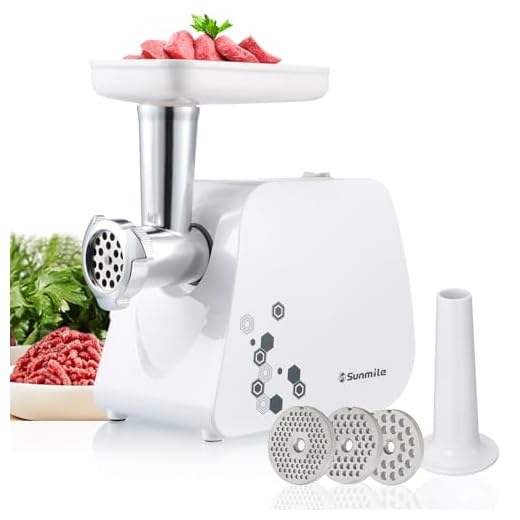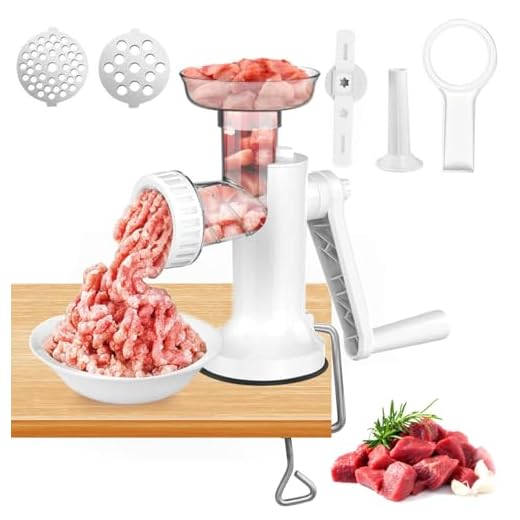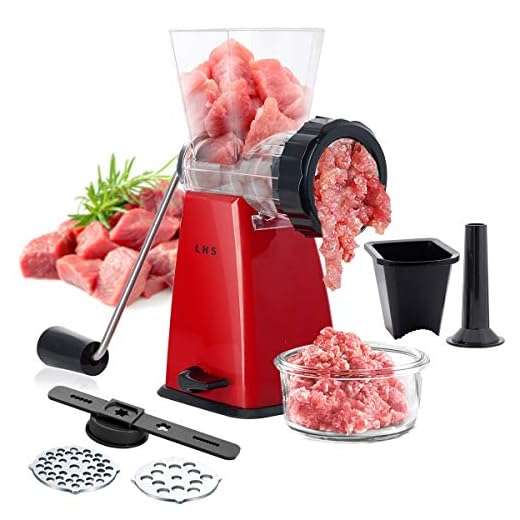
Are you looking to take your home cooking to the next level? If you have a meat grinder tucked away in your kitchen, you’re in for a treat! While you might think its only job is to grind meat, this handy appliance is incredibly versatile and can enhance your culinary adventures in ways you may not have imagined. In this blog post, we’ll uncover the top five uses for your meat grinder that will not only save you time but also inspire you to experiment with new flavors and textures. Let’s dive in and discover how your meat grinder can become a game-changer in your kitchen!



1. Grinding Meat for Fresh Sausage
Making fresh sausage at home can be a rewarding culinary adventure. With a meat grinder, you can unleash your creativity, customize flavors, and ensure quality ingredients in your sausage recipes. Let’s dive into the essential steps you need to take to get started.



Choosing the Right Cuts of Meat
Selecting the right cuts of meat is crucial for producing flavorful and juicy sausages. Here are some popular options to consider:
- Pork Shoulder: Known for its balance of meat and fat, pork shoulder is a favorite for sausage-making. The fat content helps keep the sausage moist.
- Beef Chuck: This cut offers rich flavor and a good fat-to-meat ratio, making it another excellent choice for beef sausages.
- Chicken Thighs: If you’re looking for a leaner option, chicken thighs provide great taste and moisture, especially when combined with some fatback or pork.
Recommended Meat Cuts for Different Sausages
| Sausage Type | Recommended Cuts |
|---|---|
| Italian Sausage | Pork Shoulder, Fennel Seeds |
| Bratwurst | Pork Shoulder, Beef Fat |
| Chorizo | Pork Butt, Smoked Paprika |
| Chicken Sausage | Chicken Thighs, Herbs |
The Importance of Proper Seasoning
Seasoning is what transforms your ground meat into a delicious sausage. Start with a base of salt and pepper, then experiment with various spices and herbs to create your unique blend. Here are some key seasonings to consider:
- Salt: Essential for flavor and preserving the meat.
- Black Pepper: Adds a subtle heat and complexity.
- Garlic Powder: A fantastic aromatic that enhances flavor.
- Paprika: Provides color and a smoky taste.
- Fennel Seeds: A classic choice for Italian sausages.
Creating Your Custom Blend
When crafting your sausage seasoning, you can follow a simple guideline:
- Base Ratio: Use about 1 tablespoon of salt per 5 pounds of meat.
- Herbs & Spices: Start with a teaspoon each of your chosen herbs and spices, adjusting to taste as you experiment.
Crafting Unique Sausage Flavors
Once you’ve mastered the basics, it’s time to get creative! Here are a few ideas for unique sausage flavors:
- Apple and Sage: Combine ground pork, diced apples, and fresh sage for a delicious breakfast sausage.
- Spicy Jalapeño: Add finely chopped jalapeños and cayenne pepper to pork for a zesty kick.
- Mediterranean Delight: Mix ground lamb with garlic, oregano, and lemon zest for a refreshing twist.
Tools for Flavor Exploration
To further enhance your sausage-making experience, consider investing in quality products:
- KitchenAid Food Grinder Attachment: This handy attachment is compatible with KitchenAid stand mixers, making it easy to grind meat at home.
- Cuisinart Electric Meat Grinder: A powerful model that can handle large batches, perfect for those who want to go big.
- Jerky and Sausage Seasoning Kits from Hi Mountain: These kits come with pre-measured spices and curing agents to simplify the seasoning process.
Benefits of Making Sausage at Home
Homemade sausage offers numerous benefits, making it an appealing choice for cooking enthusiasts. Here’s why you should consider grinding meat for sausage at home:
- Quality Control: You have complete control over the ingredients, ensuring no preservatives or unwanted additives.
- Cost Savings: Buying whole cuts of meat and grinding them yourself can be significantly cheaper than purchasing pre-made sausages.
- Customization: Tailor the flavors and spice levels to suit your preferences or dietary needs, whether gluten-free, low-fat, or vegetarian (using meat alternatives).
- Fun Activity: Making sausage can be a fun and engaging activity to do alone or with friends and family, fostering a sense of community and culinary exploration.
With these tips and tools at your disposal, you’re well on your way to becoming a sausage-making pro! Whether you’re whipping up a classic Italian sausage or experimenting with bold new flavors, the process of grinding your own meat and crafting fresh sausage is both satisfying and delicious.
Preparing Ground Meat for Burgers and Meatballs
When it comes to crafting the perfect burger or meatball, the foundation lies in the meat itself. Grinding your own meat allows you to have ultimate control over the fat content and quality, resulting in a more flavorful and juicier dish. Let’s dive into the process of grinding meat, selecting the right cuts, and achieving the ideal texture.

Why Grind Your Own Meat?
Grinding your own meat offers several advantages:
- Quality Control: You can choose the freshest cuts from the butcher, ensuring high quality and flavor.
- Fat Content: You can adjust the fat-to-meat ratio according to your preference (e.g., 80/20 for burgers).
- Flavor: Freshly ground meat retains more moisture and flavor compared to pre-packaged options.
Selecting the Right Cuts of Meat
Choosing the right cuts of meat is essential for both burgers and meatballs. Here are some recommended cuts and their ideal uses:
| Cut of Meat | Best For | Characteristics |
|---|---|---|
| Chuck Roast | Burgers | Well-marbled, flavorful, ideal for 80/20 ratio |
| Brisket | Burgers | Rich flavor, can add depth; mix with chuck for best results |
| Sirloin | Burgers/Meatballs | Leaner cut, great for health-conscious dishes |
| Pork Shoulder | Meatballs | Juicy and flavorful, perfect for adding moisture |
| Ground Beef Blend | Burgers/Meatballs | Custom blends can enhance flavor profile |
The Grinding Process
To get started with grinding your own meat, you’ll need a reliable meat grinder. Options include:
- KitchenAid Food Grinder Attachment: This handy attachment fits onto your KitchenAid mixer and is excellent for home use.
- LEM Products 5 Meat Grinder: A more robust option, perfect for those who plan to grind larger quantities.
Step-by-Step Guide to Grinding Meat
- Preparation: Start with cold meat. Place your chosen cuts in the freezer for about 30 minutes to firm them up. This makes the grinding process easier and helps maintain texture.
- Cut into Cubes: Trim any sinew or large pieces of fat, then cut the meat into 1-inch cubes.
- Choose Your Grind Size: Depending on your desired texture:
- Coarse Grind: For a chunkier burger or meatball.
- Fine Grind: For a smoother consistency, great for meatballs.
- Grinding: Feed the meat through the grinder. If using a stand mixer attachment, use the food pusher to guide the meat through.
- Mixing: For burgers, gently mix in seasonings and form patties. For meatballs, incorporate breadcrumbs, eggs, and spices for added flavor and binding.
Achieving the Perfect Texture
Texture plays a crucial role in the final product. Here’s how to achieve the right mouthfeel:
- Don’t Overwork the Meat: When mixing, use your hands and avoid overworking to maintain tenderness.
- Experiment with Ratios: For burgers, aim for an 80/20 ratio of meat to fat. For meatballs, a mix of 70% meat and 30% fillers (like breadcrumbs) can yield great results.
- Test Cook a Small Portion: Before forming all your patties or meatballs, cook a small piece to check for flavor and texture.
Enhancing Flavor and Juiciness
Freshly ground meat not only improves taste but also juiciness. Here are tips for enhancing flavor:
- Season Generously: Use salt, pepper, garlic powder, or onion powder directly on the meat before grinding to infuse flavor.
- Incorporate Fresh Herbs: For meatballs, adding parsley or basil can elevate the dish significantly.
- Add Fat Back: If using lean cuts, consider adding a small amount of bacon or pork fat for added richness.
By following these steps and tips, you can take your burgers and meatballs to a whole new level. Freshly ground meat not only enhances flavor but also allows you to customize your dishes to your liking. With the right tools and techniques, you’re well on your way to creating mouthwatering meals that will impress friends and family alike!
Making Fresh Ground Vegetables and Fruits
When we think of meat grinders, we often think of ground beef or sausage links, but these versatile kitchen tools can also help you whip up delicious and nutritious vegetable and fruit concoctions. From fresh salsas to vibrant sauces and even veggie patties, using a meat grinder to prepare fruits and veggies opens up a world of culinary creativity. Here’s a closer look at how you can get the most out of your grinder when it comes to plant-based ingredients.
Choosing the Right Grinder
Before diving into recipes, it’s essential to have a reliable meat grinder that can handle more than just meat. Some popular and highly rated models include:
- KitchenAid Food Grinder Attachment: This attachment is perfect if you already own a KitchenAid stand mixer. It’s great for grinding vegetables and fruits quickly and efficiently.
- STX International Turboforce 3000 Series: A powerful stand-alone grinder that can handle tough vegetables and fruits, making it a versatile addition to your kitchen.
- LEM Products #5 Electric Meat Grinder: Known for its durability and efficiency, this grinder works just as well for vegetables as it does for meat.
Best Vegetables and Fruits for Grinding
Not all produce is created equal when it comes to grinding. Here’s a quick list of vegetables and fruits that work particularly well in a meat grinder:
- Vegetables:
- Carrots: Sweet and crunchy, they add body to dishes.
- Zucchini: Adds moisture, making it perfect for veggie patties.
- Bell Peppers: Provide color and flavor to salsas and sauces.
- Onion: A fundamental flavor base, great in almost any recipe.
- Fruits:
- Tomatoes: Essential for salsas and sauces.
- Apples: Great for making applesauce or adding sweetness to dishes.
- Pears: Offer a sweet twist to sauces or breakfast items.
Preparing Fresh Salsas and Sauces
Using your grinder, you can quickly prepare fresh salsas and sauces that will elevate any dish. Here’s a basic recipe to get you started:
Fresh Tomato Salsa Recipe
Ingredients:
- 4 ripe tomatoes
- 1 small onion
- 1 jalapeño (seeds removed for less heat)
- 1/4 cup fresh cilantro
- Juice of 1 lime
- Salt to taste
Instructions:
- Start by grinding the tomatoes, onion, and jalapeño together using your meat grinder.
- Mix in the chopped cilantro, lime juice, and salt.
- Serve immediately with tortilla chips or as a topping for tacos.
Tip: For a chunkier salsa, avoid grinding too finely. You can also add corn or black beans for extra texture and nutrition.
Creating Vegetable Patties
Ground vegetables can be transformed into delicious patties that are perfect for burgers or as a side dish. Here’s a simple veggie patty recipe:
Mixed Vegetable Patties Recipe
Ingredients:
- 2 cups of ground vegetables (carrots, zucchini, and bell peppers work well)
- 1/2 cup breadcrumbs
- 1 large egg (or flax egg for a vegan option)
- 1 tsp garlic powder
- Salt and pepper to taste
- Olive oil for frying
Instructions:
- Combine the ground vegetables in a bowl with breadcrumbs, egg, garlic powder, salt, and pepper.
- Form the mixture into patties.
- Heat olive oil in a skillet over medium heat and cook the patties until golden brown on both sides.
Tip: You can experiment with spices and herbs, such as cumin or parsley, for added flavor.
Nutritional Boost
Grinding vegetables and fruits not only enhances their flavor but also increases their versatility in meals. Incorporating fresh ground produce into your diet can provide:
- Increased Fiber: Beneficial for digestion and overall health.
- Vitamins and Minerals: Fresh produce is packed with essential nutrients that support your immune system.
- Flavor Variety: Experimenting with different combinations of fruits and vegetables can keep your meals exciting and flavorful.
Final Thoughts
With a little creativity and the right equipment, your meat grinder can become a valuable tool for preparing fresh fruits and vegetables. Not only does it streamline the process, but it also opens up a realm of healthy and delicious meal options. So dust off that grinder and start experimenting with your favorite produce today!
“Unlocking Culinary Potential: Embrace Versatility in Your Kitchen”
In conclusion, your meat grinder is a powerhouse in the kitchen, opening up a world of culinary possibilities beyond just grinding meat. Whether you’re crafting delicious sausages, creating custom burger blends, or making nutritious baby food, this versatile tool can elevate your cooking game while saving you money. Take a moment to reflect on your cooking habits and preferences, and you’ll discover countless ways to make the most of your meat grinder. Embrace its potential, and let your creativity shine in the kitchen!










That sounds delicious! Spicy Italian sausage is a classic. I love experimenting with different spices too. Have you thought about trying any unique flavors like apple sage or chipotle cheddar?
I’d love to see a follow-up article on different sausage casing options. I’m confused about which ones to use for different types of sausages. Any recommendations or resources for further reading?
Great idea! Sausage casings can definitely be confusing. Natural casings are great for traditional sausages, while collagen casings are more versatile and easier to use. I’ll look into writing a follow-up piece on this!
Can you expand on the best cuts of meat to use for burgers? I usually go with chuck, but I’d love to know if there are other options that might give a different taste or texture.
I read somewhere that some people use a meat grinder to make their own pet food. Has anyone tried that? I’m curious about what kinds of meats and veggies you can use.
I love grinding my own meat for sausage! Just made some spicy Italian sausage last weekend using my KitchenAid meat grinder attachment, and it was a hit at the BBQ. Anyone else tried making their own sausages? What flavors did you go for?
Great article! Can you provide more details on how to properly clean and maintain a meat grinder after use? I’ve had a few issues with mine getting gunky.
Absolutely! Cleaning is crucial. After each use, disassemble the grinder and wash all parts in warm, soapy water. A soft brush can help get into those tricky spots. Just make sure everything is completely dry before reassembling to prevent rust.
I’d love some recommendations for good meat grinders. I was looking at the Weston 22, but I’m not sure if it’s worth the investment. What do you all think?
I’ve never thought about using my grinder for veggies! What’s the best way to use ground veggies? Can they be used in traditional recipes like meatloaf?
I’m all about making meatballs at home! I mix pork and beef for a great flavor. Just last week, I tried adding ricotta cheese to the mix, and it was a game changer. Anyone else have any fun mix-ins?
I’ve got a tip! When grinding meat for burgers, try mixing in some bacon for extra flavor! Just grind it together with the beef. You won’t regret it!
That’s a fantastic tip! Bacon adds such a rich flavor and juiciness. I’ll definitely have to try that next time I’m making burgers.
I disagree with the idea that grinding your own meat is always better. Sometimes I just grab pre-ground beef from the store for convenience. What do you all think? Is it really worth the extra effort?